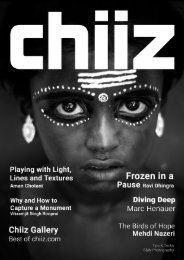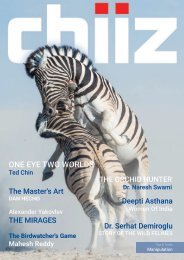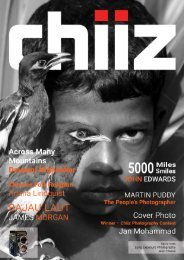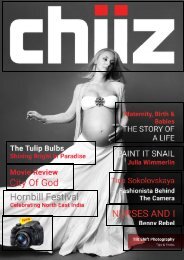Chiiz Volume 11 : Macro Photography
Macro is the genre of photography, which when perfectly captured, can take you to a different world. Be it flowers, birds, insects or any such regular subject present in our surrounding, appears completely different in the zoom lens. When it comes to macro, it requires both skills and patience. This volume is obliged to deliver you with fascinating content. The work of Nicky Bay will leave you in amusement. The beauty pf underwater world of wonderfully captured by Rudo Hvizdos. Exit Hamster will take you on a trip to Oktoberfest through his pictures. Michael Doe’s Project Maratus will introduce you with the prettiest spiders in the world. Pictures by Abd Al-rhman Nafez Hammad are simply a work of excellence. Huub De Waard provides you with the tips to capture Macro Life. The pictures of fine art nude photography, the Muses, will leave you in awe and admiration by its marvelous photography. Find this lot more amazing content in the issue.
Macro is the genre of photography, which when perfectly captured, can take you to a different world. Be it flowers, birds, insects or any such regular subject present in our surrounding, appears completely different in the zoom lens.
When it comes to macro, it requires both skills and patience. This volume is obliged to deliver you with fascinating content. The work of Nicky Bay will leave you in amusement. The beauty pf underwater world of wonderfully captured by Rudo Hvizdos. Exit Hamster will take you on a trip to Oktoberfest through his pictures. Michael Doe’s Project Maratus will introduce you with the prettiest spiders in the world. Pictures by Abd Al-rhman Nafez Hammad are simply a work of excellence. Huub De Waard provides you with the tips to capture Macro Life. The pictures of fine art nude photography, the Muses, will leave you in awe and admiration by its marvelous photography. Find this lot more amazing content in the issue.
You also want an ePaper? Increase the reach of your titles
YUMPU automatically turns print PDFs into web optimized ePapers that Google loves.
Old is Gold<br />
Rapatronic Camera<br />
by Harold Eugene Edgerton<br />
It’s often said that time doesn’t stop for anyone, but Harold Eugene<br />
Edgerton took the phrase as a challenge and made time stop for him.<br />
In the modern era, flash on smartphones and cameras have become<br />
so common that nobody questions how it came to be. It was in 1952,<br />
an era in which vacuum tubes and radios were the sizes of your<br />
couches, when Harold invented the Rapatronic Camera. The name<br />
‘rapatronic’ comes from rapid action electronic (camera). The flashes<br />
on our smartphones and cameras are a tribute to and the legacy of<br />
Edgerton. After the completion of his master’s degree from MIT in<br />
electrical engineering, Edgerton began his experiments with flash<br />
tubes. He developed the xenon flash which emitted light at regular<br />
intervals, thus proving itself to be the perfect stroboscope. It helped in<br />
capturing milk drops falling on a plate, a bullet passing an apple, etc.<br />
The xenon flash or Edgerton’s flash was capable of firing a burst of light<br />
at every 10th millisecond. Before this invention, photographic flash<br />
meant flash powder which was helpful only to produce a controlled<br />
blazing explosion. There was nothing to shoot high-speed phenomena<br />
as the speed of the shutter was very slow and worked well only when<br />
the subject was stock still.<br />
The invention of the rapatronic camera was the combination of the<br />
xenon flash and the traditional camera. It had two polarizing filters.<br />
The shutters were placed adjacent to each other at a 90 degree angle, so<br />
that no light can enter it. In the middle of the filters, a Kerr cell is placed<br />
as a replacement of a shutter. The reason behind the replacement was<br />
that the shutter was too slow to do the job of capturing movements.<br />
The Kerr cell was chosen to replace it as its polarization changes<br />
according to the applied voltage. It acted as a high speed shutter. The<br />
creation of the camera and the flash suddenly captured awe-worthy<br />
complex geometries which were previously incomprehensible to the<br />
human eye.<br />
At a time when even still photography was not overly popular, where<br />
did Edgerton get the inspiration to think of such complex designs? It<br />
was in MIT’s computer laboratory that Edgerton was performing an<br />
experiment using a computer. He saw the warning lights indicating<br />
overheating (which blinked 60 times in a second). The blinking<br />
light gave Edgerton the idea that the high-speed world can only be<br />
illuminated and captured by bursts of light by nanoseconds. Once the<br />
invention and tests were done, the struggle of selling his device began.<br />
Kodak was hesitant about this device and it believed that it would be<br />
hard to even sell 50 samples. But, the belief was proved wrong once<br />
Edgerton took a photograph of a night boxing match, which presented<br />
the fighters clearly and in clear light. From then on, the electronic flash<br />
hit emerged into the market and made millions.<br />
The rapatronic camera has helped engineers to solve various technical<br />
problems in the movements of machines and has also allowed them<br />
to examine the operation of machines. Harold Edgerton, through his<br />
photographic innovation, has made photography a diagnostic tool.<br />
Furthermore, during World War II, Edgerton successfully developed<br />
a bigger version of the stroboscope which was used to illuminate and<br />
take photos of drop zones in Normandy. It helped in the identification<br />
of areas free from Germans. After the WWII, Harold captured the<br />
initial phases of an atomic explosion. This was possible as Harold and<br />
his technical team were able to cut the shutter’s time to 1/4000000th<br />
of a second.<br />
Harold Edgerton died at the age of 86 in 1990. He is still applauded<br />
for his inventions which are a huge feat of technical excellence. His<br />
legacy continues in the usage of his inventions in various photography<br />
related fields. US President Harding himself has appreciated Harold’s<br />
photographs for their detail, color, composition and “unusual subject<br />
matter”. He comments how Harold’s inventions and photography<br />
helps in the recognition of the power of photography and its ability<br />
to “create a sense of wonder from ordinary, everyday events such as a<br />
falling drop of milk.”<br />
Harshika Kapoor<br />
harshika@chiiz.com<br />
Harshika is a 19 year old book nerd who, when not in pursuit of food, studies<br />
journalism. She's adept in the language of art, politics and all things in between.<br />
She's in possession of a selectively Type A personality and confidently takes it<br />
in her stride.












